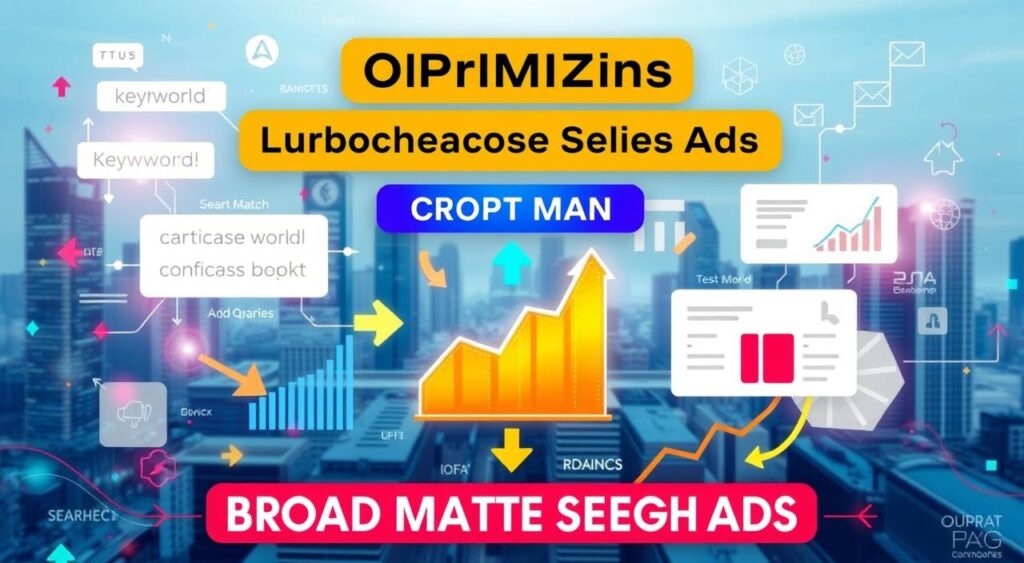Google Ads is a powerful tool, and knowing how broad match works is key. You want to understand how it matches ads with search queries. This knowledge helps your ads reach the right people, improving your ad performance.

By grasping how broad match works, you can make ads that really speak to your audience. This is vital in a competitive market like India. It helps you stand out and reach more people effectively.
Key Takeaways
- Understanding broad match is key to improving your ad performance
- What are three signals broad match uses to match search ads with queries is crucial for reaching your target audience
- Broad match helps your ads appear in front of people who are searching for what you offer
- Creating relevant ads increases the chances of conversion
- Knowing what are three signals broad match uses to match search ads with queries can give you an edge in a competitive market
- Broad match is a powerful tool for advertisers in India
Understanding Broad Match in Google Ads
Exploring Google Ads means learning about broad match. It’s a keyword type that lets your ads show up for many related searches. This way, more people can see your ads, which might lead to more sales.
Broad match works by matching your ads with searches that fit your keywords. It looks for synonyms, related searches, and even typos. Using broad match can make your ads more visible to a wider audience.
Using broad match in Google Ads has several benefits:
- More people see your ads
- Your campaign can do better and make more money
- Your ads can be more relevant to what people are searching for
To make the most of broad match, you need to set up your campaigns right. Choose the right keywords and keep an eye on how your ads are doing. This way, you can improve your ad success and meet your marketing goals.
Understanding and using broad match in Google Ads can boost your marketing. It’s useful for both experienced marketers and newcomers. Broad match helps you reach more people and get more conversions.
The Three Signals Broad Match Uses to Match Search Ads with Queries
Broad match uses three key signals to match search ads with queries. These signals help advertisers reach their target audience and improve ad performance. Understanding these signals can help optimize campaigns for better results.
The three signals capture the essence of a user’s search query. They match it with the most relevant ad. This is done by analyzing user intent and search context, landing page content analysis, and historical performance data. This way, broad match provides a more accurate and relevant ad experience for users.
Signal #1: User Intent and Search Context
This signal focuses on understanding the user’s intent behind their search query. It analyzes the words and phrases used in the query. This helps match the user with the most relevant ad.
Signal #2: Landing Page Content Analysis
This signal looks at the content of the landing page associated with the ad. It examines the keywords, phrases, and theme of the page. This helps determine its relevance to the user’s search query.
Signal #3: Historical Performance Data
This signal uses historical data to inform ad matching decisions. It analyzes the performance of previous ads. This helps identify which ads are most likely to perform well for a given query.
By leveraging these three signals, you can create more effective ad campaigns. Focus on user intent, landing page content, and historical performance data to get the most out of broad match.
How Broad Match Signals Impact Your Ad Performance
Exploring Google Ads means learning about broad match signals and their role. These signals are key to your ad’s success. They help your ads show up in searches that match what users are looking for.
Optimizing broad match signals can boost your ad’s visibility. This leads to more clicks and conversions. For example, if someone searches for “best restaurants in India”, your ad might show up if it’s well-targeted.
Improving your ad’s performance involves a few important steps:
- Make sure your ad is relevant to what users are searching for.
- Ensure your landing page is user-friendly and relevant.
- Choose the right keywords to reach your target audience.

By focusing on broad match signals, you can make your ads more effective. This means better results for your investment. Always keep an eye on your campaigns to make sure they meet your audience’s needs.
Read More: Which Three Factors Impact a Search Ad’s Auction-Time ad Aurality?
Optimizing Your Campaigns for Better Broad Match Results
To get the most out of broad match, you need to optimize your campaigns. This means making sure your landing pages match the user’s search query. It also involves enhancing your audience signals and monitoring your performance to keep improving.
When optimizing campaigns for broad match, focus on relevance and user experience. This will help your ad show up more and increase chances of conversion. Here are some tips to help you optimize your campaigns:
- Ensure your landing pages are well-structured and easy to navigate.
- Use clear and concise language in your ad copy and landing pages.
- Make sure your call-to-action is prominent and easy to click.
By following these tips and keeping an eye on your performance, you can make your campaigns better. Remember, optimizing campaigns for broad match is a continuous process. It needs regular checks and tweaks for the best results.

By focusing on optimizing campaigns for broad match, you can make your ad more visible. This will lead to more conversions and sales. So, start optimizing your campaigns today and see the difference for yourself!
| Optimization Tips | Benefits |
|---|---|
| Landing Page Optimization | Improved Relevance and User Experience |
| Audience Signal Enhancement | Better Match with User Intent |
| Performance Monitoring | Continual Improvement of Campaign Effectiveness |
Conclusion: Maximizing Your Ad Success with Broad Match Signals
The three key signals for Google Ads’ broad match targeting are very important. They are user intent, landing page content, and historical performance data. By using these, you can make your ads more effective and reach the right people.
Using broad match signals is an ongoing process. You need to keep checking how your campaigns are doing. Look at what users say and make changes based on data. This way, your ads will keep connecting with your audience.
Don’t be scared to try new things in digital ads. What works today might not tomorrow. Stay flexible and open to new ideas to find what works best for your business.
By using broad match signals, you can make your ads more successful. This will help your brand grow. So, start making changes to your campaigns now. See how your ads can improve and grow.
FAQ
What are three signals broad match uses to match search ads with queries?
Broad match in Google Ads uses three key signals to match search ads with relevant queries:
What is User Intent and Search Context?
Broad match looks at the user’s search intent and the context of their query. It considers the searcher’s location, device, and search history.
How does Landing Page Content Analysis work?
Broad match also checks the content and relevance of your landing page. It makes sure the ad matches the user’s query. The landing page’s content, keywords, and user experience are all important.
What is the role of Historical Performance Data?
Broad match uses your campaign’s past performance data. It learns which queries lead to conversions. This helps the system match your ads to the right searches over time.
𝐒𝐰𝐚𝐠𝐚𝐭 𝐆𝐚𝐰𝐚𝐝𝐞
Digital Marketer | Content Creator | Growth Strategist
With 2 years of hands-on experience in the dynamic world of digital marketing, Swagat Gawade specializes in crafting compelling strategies that drive growth and engagement. From managing ad campaigns to optimizing SEO, Swagat has a proven track record of boosting brand visibility and achieving measurable results.
Key skills:
𝐒𝐨𝐜𝐢𝐚𝐥 𝐌𝐞𝐝𝐢𝐚 𝐌𝐚𝐫𝐤𝐞𝐭𝐢𝐧𝐠: Building impactful campaigns that resonate with audiences.
𝐂𝐨𝐧𝐭𝐞𝐧𝐭 𝐌𝐚𝐫𝐤𝐞𝐭𝐢𝐧𝐠: Creating engaging, high-quality content tailored to target markets.
𝐒𝐄𝐎 & 𝐒𝐄𝐌 𝐄𝐱𝐩𝐞𝐫𝐭𝐢𝐬𝐞: Ensuring brands rank high and stay competitive in search results.
𝐀𝐧𝐚𝐥𝐲𝐭𝐢𝐜𝐬 𝐏𝐫𝐨𝐟𝐢𝐜𝐢𝐞𝐧𝐜𝐲: Leveraging data to refine strategies and enhance ROI.
Swagat’s passion for learning fuels a constant pursuit of innovative marketing solutions, making him a valuable asset in today’s fast-evolving digital landscape.


